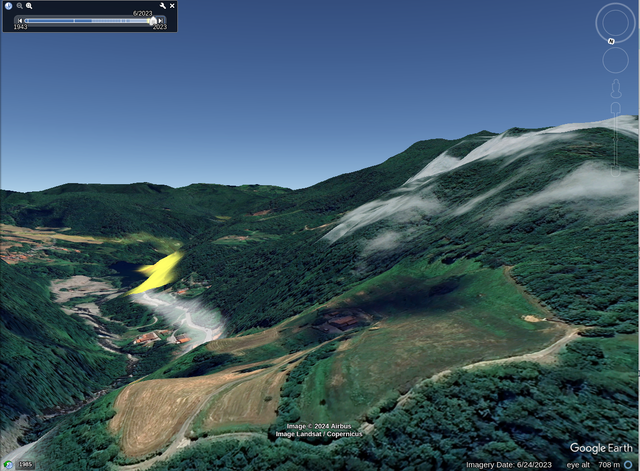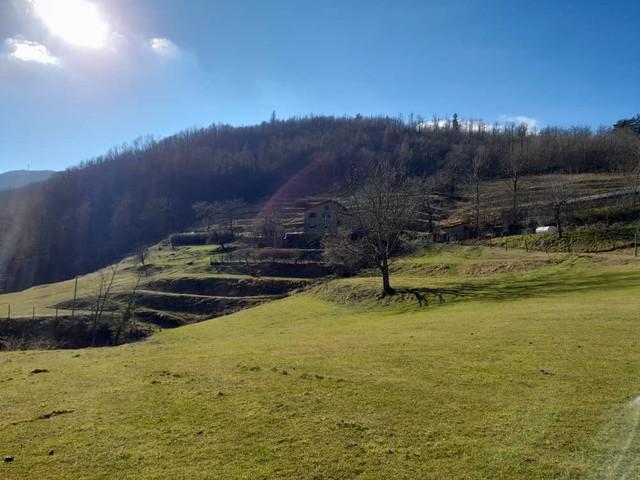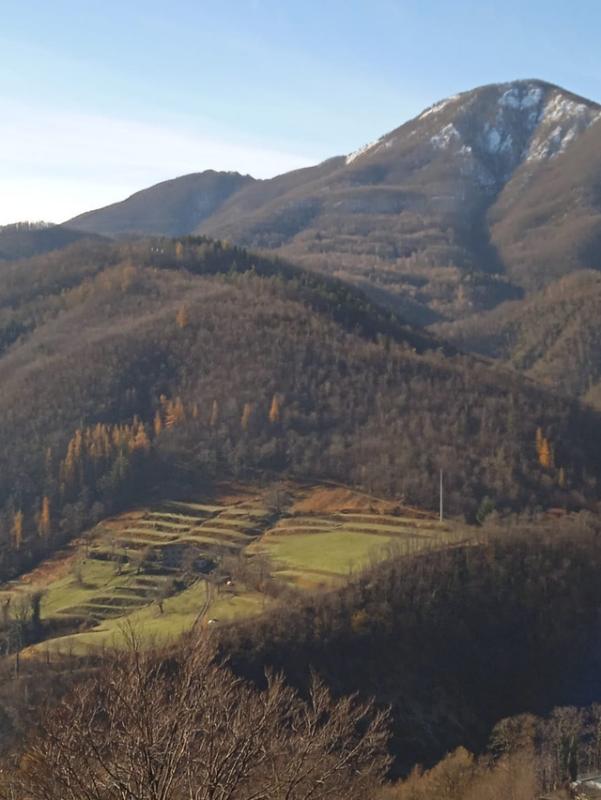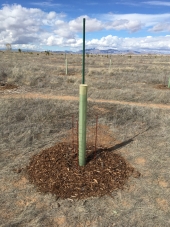Hi Guys.
I'm Remy, 33 years old. I'm from Borgo San Lorenzo, Tuscany, Italy. I've loved plants and trees since I was very young. I've always planted in other people's gardens, which gave me joy and satisfaction, but was sometimes (often) frustrating because the trees were not followed up/were badly pruned/were rooted. For this reason, I've always said to myself "one day, I'll have my own farm".
In 2023, my dream came true. I am the proud owner of a 50 acres (75% woods, 25% terraced pasture) farm in North Tuscany.
Climate, soil
- Avg. yearly rainfall: 2,000 mm (79 inches). Lots of rain, but with relatively dry summers.
- Altitude : 700m (2,300 ft)
- Soil : 5,5 <pH<6,5, sandy loam, quite deep for a slope soil (> 1,20 m). No waterlogging, very good water infiltration, tendency to dry on some sloppy parts of the property. Water and ice-related erosion points, primarily due to overgrazing in the past, kickstarting erosion patches
- Exposure: East
- Winds: North wind is dominant in winter, South in summer. It is not a windy place all over the year, but when there are big, windy storms (5 a year +-), winds can be very strong (as far as 120 km/h).
Some cool features
- Property water source originating in the woods. It comes from above, making it ideal for gravity-irrigation if needed. It also supplies the house.
- Self-sufficient in energy (photovoltaic panels)
- Self-sufficient heating (wood-fired boiler)
- Terraces created by the elders in the steepest fields
- Apple, plum, cherry, pear, walnut, hazelnut and raspberry trees already scattered around the property. The woods are 70% chestnut, of which 20% approx are sweet.
Challenges I’ve spotted so far
- Strong slopes so every movement, especially loaded, takes energy
- Poor accessibility: the dirt road is short and close to the main road, but the entrance is on a dangerous bend. As it is, leaving the property is dangerous if you don't know how to do it properly.
- Not a windy place, but when storms occur, venturi effect can push winds up to 120 km/h
- Contextual challenge: no access to cheap organic material (manure, straw, wood chips…). Gotta work with cover crops (and I love the idea but it’s challenging)
- Three wild plant species are very vigorous here: brambles, ferns, broom. Converted this challenge into a resource. Brambles give me blackberries, ferns make an excellent mulch, brooms are good for all the erosion control earthworks I'm doing
- Italian bureaucracy
Some views of the farm
The project
If I had to choose, I’d say my mentors are Sepp Holzer, Mark Shepard, Masanobu Fukuoka, Brad Lancaster. But there are but there are so many more...
My project is not yet well defined and is constantly evolving. Here is my idea to date (June 2024):
WATER
For the moment, I have no intention of setting up large ponds, firstly because my soil is sandy loam, and secondly because Italian bureaucracy is already giving me a hard time (we'll see later). For the moment, I'm taking advantage of my gravity-fed spring by setting up mini water reserves scattered around the property.
TREES AND CROPS
-> On the land closest to the house (300m2 terraces in total): family vegetable garden (it's already in place). Two terraces can be added.
-> On the three larger, relatively flat plots: keyline- planted, high-stemmed, old variety fruit trees. Plantings sufficiently spaced to accommodate intercropping. I’d love to intercrop using Fukuoka’s natural farming techniques.
-> The upper terraces: fruit trees planted in patches, in a less organized way, with the possibility of growing vegetables and annuals in the "clearings". Those terraces follow the dominant winds so I really need to slow them down, that’s why I wouldn’t choose more classical row planting.
-> The fruit trees will not only be a source of fruit harvests, they will also become the mother plants for harvesting scions for my future fruit nursery.
HEDGES
I'm planting a lot of trees (poplar, oak, maple, lime, mulberry, plane, liquidambar...) that I'll be pruning (pollards) to provide wood and organic matter. However, I need to add one or two layers to provide a windbreak for the south and north winds, as well as an additional food source for wildlife and my family.
FERTILITY
No external organic inputs, as they are very expensive and not readily available. I have the advantage of having a plot much larger than my family needs, so I can mow part of the meadow for mulching, and use other abundant (some would say invasive) resources: brambles, broom and ferns in particular. And, of course, cover crops.
ANIMALS
Very drastic choice here: no animals planned to date (my family and I have a foot on each continent, and that's not going to change soon). I'm very open to ideas, because I know how important animals are in a farm.
Monies
As of today, my plan is to pay my daily expenses with wifi money and to not depend on the farm for generating income. In the future, the fruit tree nursery and the fruit and vegetable harvests could bring in significant revenue.
Prior to project implementation: knowing how to let go, and taking responsibility for doing things differently. Please help guys lol
Before going into detail and discussing about the exciting possibilities of this project, I'd like to share with you some uncertainties I face. I feel I have a responsibility towards locals to ensure "farm's continuity", i.e. to make sure the place stays as "clean" as it has always been before me. I think I feel a certain external pressure, expectations of a "stranger who would come and buy the farm without knowing how to manage it" (I'm from a village 100 miles from the farm, nobody knew me before I bought. I work in food world, but I don't have practical agriculture experience, except my passion for plants, neither had my parents). The farm facing the whole village doesn't help lol. I don't know if I'm clear!
Although I try to ignore these uncertainties, they do have an impact on my actions, on two levels in particular:
- Electric fence: the meadows are surrounded by 1km of 5-wire electric fence. The previous owner had put it up because he had 200+ sheeps, against wolf attacks. This fence can be an asset for my future crops protection against grazing (fruit trees, vegetables, berries, etc.), but it requires an enormous amount of maintenance work (weeds, brambles, young trees, ferns). I always give importance to popular wisdom and for them it's inconceivable to have crops here, in this context, without protecting them from deers and boars. It's a kind of continuous and relentless struggle, which takes an inordinate amount of time, and is not in phase with the vision I want to imprint on the farm (natural farming,...). For now, I'm keeping the maintenance everyday because I feel it's an asset I will lose if I let Mother Nature take over. Do you think I should give up on fence maintenance once and for all and let the wildlife take over? Once I've made that decision, I won't be able to go back because the brambles will quickly take over everything. One thing's for sure, spending my days pulling brambles and cutting grass under the wires with a brushcutter and hand tools doesn't make sense, given my plans for this farm.
- Maintaining meadows against the progress of the forest: in the same style, I see ecological successions advancing in the most difficult-to-access areas of the meadows (slopes, property edges...) and I feel this "duty" to keep them "as they were" and prevent the forest from gaining ground. We agree once for all, we put aside these useless pressures and learn not to give a damn about other people's opinions?

There's so much more to say, but I think I've covered the essentials for now! I look forward to reading your opinions, feedback and reviews.
See you soon!
Remy

 5
5









 2
2










 4
4





 3
3




 1
1










 2
2










 5
5














 4
4




 1
1




 1
1






















